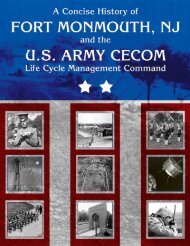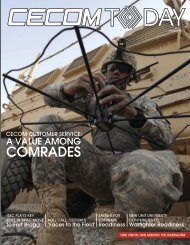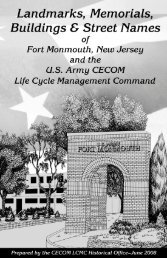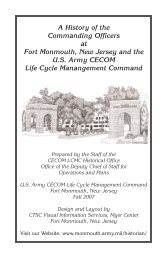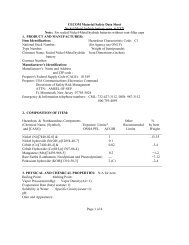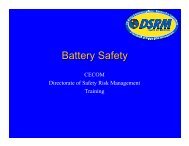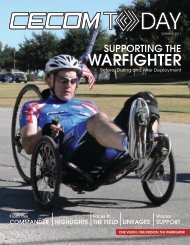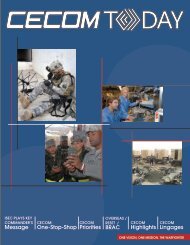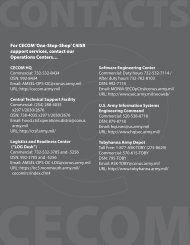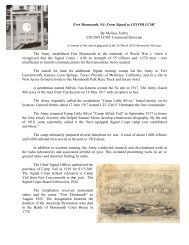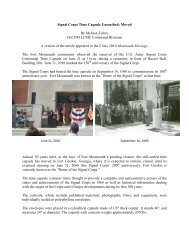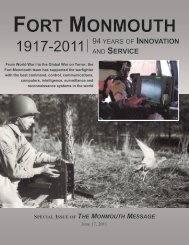A Signal Corps space odyssey - CECOM - U.S. Army
A Signal Corps space odyssey - CECOM - U.S. Army
A Signal Corps space odyssey - CECOM - U.S. Army
You also want an ePaper? Increase the reach of your titles
YUMPU automatically turns print PDFs into web optimized ePapers that Google loves.
ARl'TY C~UN I CATOR) ~'JINTER 1982) VOL I 7) No I 1<br />
A <strong>Signal</strong> <strong>Corps</strong> <strong>space</strong> <strong>odyssey</strong><br />
Part 11-<br />
and<br />
beyond<br />
"This is the President of the United States speaking.<br />
Through the marvels of scientific advance, my voice is<br />
coming to you from a satellite traveling in outer <strong>space</strong>. My<br />
message is a simple one: Through this unique meansI convey<br />
to you and all mankind, America's wish for peace on earth<br />
and good will toward men everywhere."<br />
- President Dwight David Eisenhower, December 19, 1958<br />
This is the story of SCORE, the<br />
world's first communications satellite<br />
and the final phase of other pioneering<br />
contributions of the <strong>Signal</strong> <strong>Corps</strong> to the<br />
early <strong>space</strong> age. They all, and<br />
particularly SCORE, represent some of<br />
the <strong>Signal</strong> <strong>Corps</strong>' most memorable<br />
achievements. It has been said that<br />
"success has a thousand fathers but<br />
failure is an orphan;" and SCORE,<br />
COURIER and TIROS were all<br />
remarkable successes!<br />
As a major participant in these<br />
projects, I would like to share with all<br />
<strong>Army</strong> communicators, young or old,<br />
my recollections of what really<br />
happened without going into nitty-
with representing his personnel's<br />
collective, specialty-related professional<br />
development interests.<br />
To insure that personnel<br />
management policies, programs and<br />
procedures, established by HQDA,<br />
incorporate the specialty-related<br />
recommendations of the designated<br />
proponent agencies - primarily in<br />
personnel management, training and<br />
doctrine, standardization and<br />
evaluation, stability and cohesion, and<br />
force modernization.<br />
To foster the achievement of the<br />
underlying goals and objectives of the<br />
<strong>Army</strong>'s Officer Personnel Management<br />
System, the Enlisted Personnel<br />
Management System, the Warrant<br />
Officer Career Management Policies<br />
and Programs, and those professional<br />
development policies and programs<br />
applicable in the special branches.<br />
The specific advise and assist<br />
proponent responsibilities given to the<br />
commandant under AR 600-10 I can be<br />
grouped into four functional areas:<br />
matching soldiers, training and unit<br />
needs; insuring professional<br />
development opportunities; matching<br />
civilian education with force needs; and<br />
providing representation on<br />
proponency committees.<br />
On August I, 1981, the<br />
commandant USASC established. the<br />
<strong>Signal</strong> Warrant Officer Proponency<br />
Committee which serves as the focal<br />
point and advisor to the commandant<br />
for all <strong>Signal</strong> Warrant Officer matters.<br />
Using internal resources, the Warrant<br />
Officer Committee is composed of<br />
eleven members: warrant officer<br />
representative from each warrant MOS<br />
(252 - calibration and repair technician,<br />
286A C-E equipment repair<br />
technician, 287 A - data processing<br />
systems repair technician and 290A -<br />
telecommunication technician), one 04<br />
or above from both the Officer<br />
Development Division and the Officers<br />
Department, a sergeant major<br />
representing CMF 28, 29 and 31 as well<br />
as a representative from the Officer<br />
Personnel Section, MILPO,<br />
Directorate of Personnel and<br />
Community Activities (DPCA).<br />
SPECIALTY PROPONENT Q<br />
Q<br />
DIRECTOR<br />
SIGNAL CENTER DIRECTORATE OF TRAINING<br />
FOCAL POINT DEVELOPMENTS<br />
iSIGNAL CENiER-~<br />
: PROPONENCY :<br />
~__~Q~J~IJI§L_~<br />
: • MEMBERS :<br />
~------- -------'<br />
r" --- - -- - - - - -- - -- ------- --- -- -- - ---- --- --- ------- - --,<br />
'<br />
, 0<br />
r'----.l.----,<br />
r'----~-----l<br />
i OFFICER i WARRANT OFFICER i ENLISTED:<br />
~-,!'.~§~~~~~~j PRESIDENT ll~!.'l_E_~IQ~~~<br />
Using the Warrant Officer<br />
Committee as a model, there will be<br />
established commissioned officer and<br />
enlisted proponent committees. These<br />
three (working) committees will address<br />
issues, research problems, develop<br />
positions and recommendations to the<br />
commandant for presentation to<br />
MILPERCEN (see chart).<br />
The <strong>Signal</strong> Center Proponency<br />
Committee, under direction of the<br />
commandant, will consist of a signal<br />
administrative staff which will include<br />
the presidents of the three working<br />
committees plus outside agencies and<br />
command representation as<br />
appropriate. The function of this<br />
committee will be to coordinate issues<br />
both internally and externally,<br />
consolidate positions, provide guidance<br />
to the working committees and<br />
represent the USASC on proponency<br />
matters. The director of the Directorate<br />
of Training Developments will be the<br />
focal point and provide guidance and<br />
overall direction to both the<br />
proponency committee and the working<br />
committees.<br />
The relationship of the USASC to<br />
MILPERCEN and other proponent<br />
agencies is currently undefined. USASC<br />
will not become involved on an<br />
individual basis with assignments or<br />
career planning, nor will it maintain<br />
individual files, records or have official<br />
contact with individuals other than to<br />
collect data and information. USASC<br />
does, however, anticipate a continued<br />
close working relationship with the<br />
commissioned officers, warrant officers<br />
and enlisted branches of MILPERCEN<br />
as well as other proponent agencies.<br />
Proponency issues and problems<br />
are endless and often related. Therefore,<br />
we solicit issues or problems, developed<br />
solutions and recommendations not<br />
only from <strong>Signal</strong> personnel but from all<br />
agencies, organizations and individuals.<br />
Correspondence should be addressed<br />
to:<br />
COMMANDER<br />
USASC&FG<br />
ATTN: ATZH-TDP<br />
FORT GORDON, GA 30905<br />
Specialty Proponency office telephone<br />
numbers are:<br />
Commissioned Officers<br />
(A V) 780-3417<br />
COMER (404) 791-3417<br />
Warrant Officers<br />
(A V) 780-2058/7974<br />
COMER (404) 791-2058/7974<br />
Enlisted (A V) 780-7468<br />
COMER (404) 791-7468<br />
Include your AUTOVON number<br />
so we may contact you.
gritty technical details which have been<br />
published widely in the open literature.<br />
In 1958 1 was a colonel assigned to<br />
the <strong>Army</strong> Electronics Proving Ground<br />
(AEPG) at Fort Huachuca, Arizona. 1<br />
was nearing the end of a tour of duty as<br />
chief of the Electronic Warfare<br />
Department when I received a<br />
telephone call from Maj. Gen. Emil<br />
Lenzner in the Pentagon. Lenzner had<br />
been Commanding General of the<br />
AEPG but had recently gone on to the<br />
Pentagon where he had become the<br />
Deputy Chief <strong>Signal</strong> Officer.<br />
Lenzner's call was to set in motion<br />
events which brought me to the most<br />
exciting, most satisfying and best tour<br />
of duty of my entire thirty year military<br />
career. He told me that the Chief <strong>Signal</strong><br />
Officer, Gen. O'Connell, wished to<br />
know if I would like to be assigned as<br />
the commanding officer of the <strong>Signal</strong><br />
Research and Development Laboratory<br />
(SRDL) at Fort Monmouth, N.J. 1 had<br />
been assigned to Fort Monmouth<br />
before and although 1 was surprised at<br />
being considered for such an<br />
assignment, a friend, Brig. Gen. E. F.<br />
Cook, had commanded the laboratory<br />
for the previous three years and I knew<br />
he had enjoyed the assignment. So 1told<br />
General Lenzner 1would like to accept.<br />
Command assignment to an R&D<br />
laboratory is uniquely different in two<br />
aspects from any other regular military<br />
command duty. First, a laboratory of a<br />
predominantly civilian workforce of<br />
scientists and engineers, including a<br />
scattering of professionally prominent<br />
prima donnas, cannot be managed like<br />
a troop command. More freedom of<br />
action and a relaxed military discipline<br />
must be granted to keep them motivated<br />
and productive.<br />
Second, whereas a commander of<br />
regular military activities can observe<br />
the effects of his decisions mostly on a<br />
day by day basis, in a laboratory the<br />
results may not come to light for a long<br />
time, often not before his departure to<br />
other duty since the complex process of
A <strong>Signal</strong> <strong>Corps</strong> <strong>space</strong> <strong>odyssey</strong><br />
R&D takes a long time from initiation<br />
to completion - which leaves a lot of<br />
room for arguments of fathership for<br />
both good and bad ideas. At any rate,<br />
the commander of an R&D activity<br />
faces some rather unique peculiarities,<br />
which call for unorthodox management<br />
approaches and sometimes seem to<br />
create odd sentiments in command<br />
transfer and succession not prevalent in<br />
other military assignments.<br />
But let me come to the main<br />
subject: SCORE. Right from the start<br />
of the satellite program in 1955, the<br />
<strong>Signal</strong> <strong>Corps</strong> - and particularly SRDL<br />
had been crusading through<br />
proposals, presentations and<br />
recommendations for the early<br />
utilization of satellites for its<br />
communications needs. The basic idea<br />
was by no means new. In science fiction<br />
stories, satellites had long been loaded<br />
with communications gear and realistic<br />
and detailed theoretical studies existed<br />
in the open literature since 1952. But<br />
something practical had to be done<br />
about it now.<br />
The IGY program strictly ruled out<br />
any applications tests and consequently<br />
our sights had to be focused on the<br />
military satellite programs which were<br />
expected to follow. In this respect, we<br />
hoped that our close relationship with<br />
the <strong>Army</strong> Ordnance <strong>Corps</strong> and the<br />
ABMA, for which we provided<br />
significant support in electronics, would<br />
secure us priority consideration in their<br />
planned programs. But that was not so.<br />
Gen. J. B. Medaris as well as Dr.<br />
Wernher von Braun were not too keenly<br />
interested in communications satellites.<br />
Although they appeared fully confident<br />
of the soundness of the principal and of<br />
their future importance, they felt they<br />
had, at that time, not enough appeal to<br />
impress the nation and Congress<br />
sufficiently to give urgently wanted<br />
greater support to <strong>space</strong> programs.<br />
After all, the general public probably<br />
couldn't care less whether a telephone<br />
connection was provided by cable,<br />
ground based radio, or satellite relay<br />
until satellites would make possible<br />
real-time global TV transmission which<br />
low altitude satellite orbits could not yet<br />
offer. Medaris felt that highest priority<br />
belonged to an eye in the sky<br />
surveillance satellite which would stun<br />
the nation and the world by furnishing<br />
detailed pictures globally.<br />
Nevertheless, we were promised a<br />
piggy-back ride for communications<br />
equipment when extra weight on<br />
another main payload should become<br />
available. But,' assisted by the chief<br />
signal officer, we kept our eyes wide<br />
open for other and earlier opportunities<br />
which, fortunately, would soon<br />
develop.<br />
On 29 May 1958, we had a VISit<br />
from the Secretary of the <strong>Army</strong>, Wilbur<br />
Brucker, who was accompanied by Gen.<br />
O'Connell and in our briefings we made<br />
a strong pitch for communications<br />
satellites, which seemed to impress<br />
Brucker.<br />
As a consequence, Gen. O'Connell<br />
came back for another visit on 23 June.<br />
This time he brought with him the<br />
director of ARPA, Roy Johnson. Fully<br />
aware of Johnson's sweeping power in<br />
the satellite field, we made an all out<br />
effort to convince him of the urgency of<br />
communications satellites as a matter of<br />
national emergency. We did not have to<br />
wait long for the gratifying result.<br />
Within a few days, we received an<br />
urgent telephone call from the office of<br />
the chief signal officer, prompted by<br />
ARP A. It reauested a quick answer to<br />
what kind of satellite communications<br />
equipment we could put together in 60<br />
days if we were allowed a weight of 150<br />
pounds on a rocket which would be sent<br />
into orbit. The SRDL workforce, wellprepared<br />
for such an opportunity,<br />
responded promptly with design plans<br />
and presentations, and in early July we<br />
received ARPA authorization to<br />
proceed. Thus project SCORE was<br />
born.<br />
The project provided for an Air<br />
Force Atlas ICBM to be launched from<br />
Cape Canaveral, Florida. Since the<br />
entire one-stage rocket of some 9000<br />
pounds was to be placed into orbit, no<br />
separate satellite payload configuration<br />
was planned and the communications<br />
equipment was to be properly<br />
integrated into the fairing pods of the<br />
missile. A relatively low orbit and a<br />
correspondingly short life expectancy<br />
of this satellite of some 2 to 3 weeks,<br />
called for the use of battery power<br />
rather than a long-life solar power<br />
supply.<br />
In view of the relatively low orbit<br />
expectation and the related limited<br />
opportunities for simultaneous access<br />
to the satellite from various ground<br />
stations, the SRDL-designed<br />
communications equipment included a<br />
store-and-forward mode through a tape<br />
recorder subsystem in addition to a realtime<br />
radio relay capability. Thus, even<br />
for the low orbit, worldwide delayed<br />
message delivery or "courier service"<br />
The world's first satellite to relay the<br />
human voice through <strong>space</strong> was placed<br />
in orbit on 18 December 1958 through<br />
Project SCORE. President Eisenhower's<br />
Christmas message proved<br />
that voice and code could successfully<br />
be relayed or stored and forwarded by<br />
satellites over tremendous distances.<br />
.,<br />
~'J. T<br />
" .,<br />
!. e
could be demonstrated. Considering the<br />
risk of a communications package<br />
which included electromechanical<br />
devices, such as a tape recorder, it was<br />
decided to provide redundancy by<br />
orbiting two independent copies of the<br />
equipment. The capacity of the system<br />
was one voice channel or seven 60 wpm<br />
teletype channels, frequency division<br />
multiplexed. The tape recorder had a<br />
four-minute capacity for either<br />
recording or playback.<br />
To accomodate the 30° south<br />
inclination of the projected orbit,<br />
special ground stations for satellite<br />
interrogation and communications had<br />
to be located at Fort McArthur,<br />
California; Fort Huachuca, Arizona;<br />
Fort Sam Houston, Texas; Fort<br />
Stewart, Georgia; and Cape Canaveral,<br />
Florida.<br />
As this project - sponsored and<br />
funded by ARPA with the Air Force<br />
having vehicle responsibility and the<br />
<strong>Army</strong> <strong>Signal</strong> <strong>Corps</strong> in charge of the<br />
payload - proceeded in deep secrecy,<br />
the 60 day deadline was soon extended<br />
to 90 days as the Atlas schedule slipped.<br />
The timely completion of our own part<br />
was aided by contractual industry<br />
assistance by RCA and others. The<br />
integration of missile and payload<br />
required close cooperation between Air<br />
Force and <strong>Signal</strong> <strong>Corps</strong>.<br />
But in September 1958 (incredibly<br />
to us) we received word from ARPA<br />
that the project had been cancelled. The<br />
cancellation was followed by a directive<br />
to continue the work with no change in<br />
deadlines as an important exercise for<br />
the purpose of using the equipment for<br />
communications tests in helicopters,<br />
airplanes and other flying devices short<br />
of satellites.<br />
Actually the "cancellation" was<br />
only a ploy to shroud the project into<br />
super secrecy. When it happened, we<br />
could not understand the underlying<br />
reasons. It was later explained that<br />
President Eisenhower, angered by<br />
security leaks on other <strong>space</strong> vehicle<br />
launches and associated embarassments,<br />
had threatened ARPA with<br />
actual project cancellation should any<br />
information leak out before the launch<br />
of the Atlas. As a result, only those<br />
individuals at ARPA, the Air Force and<br />
the <strong>Army</strong> qualified for a "need to know"<br />
since failure to inform them could have<br />
directly endangered the timely<br />
completion of SCORE. The 88 people<br />
who were selected to know became the<br />
now famous "Club 88."<br />
Maintaining the super secrecy over<br />
almost three months was quite difficult<br />
and caused much confusion, especially<br />
in the preparation of the ground<br />
stations. At one point I was told that<br />
Maj. Gen. F. Moorman, the CG of the<br />
AEPG at Fort Huachuca, threatened to<br />
have our people evicted from his post by<br />
the MPs unless he got some explanation<br />
of our clandestine activities.<br />
Finally, the Atlas with its SCORE<br />
payload was standing on the launching<br />
pad at Cape Canaveral, ready to go.<br />
But then one more unexpected<br />
problem developed. To start off the<br />
SCORE operations, we had<br />
prerecorded a message into the tape<br />
recorder. It was a paragraph from a<br />
nonpolitical, patriotic document of US<br />
history and nobody seems to recall any<br />
longer what it actually was. The late<br />
Herbert Hawkins, a member of the<br />
SRDL-SCORE team, who had a very<br />
pleasant voice, had recorded it and it<br />
was also contained in teletype mode.<br />
Now,just hours before the takeoff,<br />
another tape recording was hurriedly<br />
brought to Cape Canaveral, which was<br />
to replace the one already in the<br />
recorder. Roy Johnson, who had kept<br />
President Eisenhower well informed on<br />
progress, had in a last minute effort<br />
succeeded in convincing the President<br />
that SCORE would be a splendid<br />
opportunity to broadcast a Christmas<br />
peace message to the world and here it<br />
Dr. Hans K. Ziegler (left) and then Co!.<br />
H. McD. Brown (right) talk with Dr.<br />
Werner Von Braun after one of his visits<br />
to USAS'RDL, Fort Monmouth, New<br />
Jersey, 13 November 1959.<br />
was. Since there was no longer any<br />
physical access to the SCORE<br />
equipment at the pad, the substitution<br />
of the prerecorded messages had to be<br />
done by radio interrogation and<br />
transmission with the risk that the ever<br />
alert news media might intercept it and<br />
prematurely publish it. But in the wee<br />
hours of Thursday, 18 December 1958,<br />
the <strong>Signal</strong> <strong>Corps</strong> team succeeded in this<br />
tricky task.<br />
At 1802 hours, the long awaited<br />
launch took place with everyone full of<br />
anxiety over the outcome. How great<br />
was the joy when the tracking data<br />
confirmed within minutes of rocket<br />
burnout that orbiting had been<br />
successful. The Air Force had<br />
convincingly proven the capability of its<br />
Atlas ICBM. But, we wondered, would<br />
our communications equipment be<br />
equally successful?<br />
The operational plan called for<br />
interrogation on the first orbit by the<br />
California ground station to receive and<br />
record the President's message and at<br />
once transmit it by telephone via the<br />
Pentagon to the White House for public
A <strong>Signal</strong><br />
release. But interrogation of the first of<br />
the two SCORE packages was<br />
responded to only by a transmission of<br />
an unmodulated carrier and the quick<br />
switch to interrogate the second<br />
package obviously was too late to<br />
produce conclusive results during the<br />
first orbit. Though we were not fully<br />
discouraged by this result, we<br />
nevertheless spent a sleepless night and<br />
anxiously waited for the twelfth orbit<br />
which would be suitable for another<br />
chance of interrogating the second<br />
SCORE package. This occurred at 1515<br />
hours on 19 December and was<br />
accomplished by our SRDL team at<br />
Cape· Canaveral. The message came<br />
down loud and clear from the satellite:<br />
This is the President of the United<br />
States speaking. Through the marvels<br />
of scientific advance, my voice is<br />
coming 10 you from a satellite traveling<br />
in outer <strong>space</strong>. My message is a simple<br />
one: Through this unique means I<br />
convey 10 you and all mankind.<br />
America's wish for peace on earth and<br />
good will toward men everywhere.<br />
During the next two weeks, the<br />
second SCORE package continued to<br />
work perfectly in 78 interrogations in all<br />
modes of communications - real-time<br />
relay over long distances and store-andforward<br />
on a global basis, both in voice<br />
and teletype. The first package failure<br />
was later diagnosed as a malfunctioning<br />
of the tape recorder, probably by the<br />
jamming of a take-up reel. How<br />
fortunate that we had worried along<br />
these lines and provided equipment<br />
redundancy.<br />
The <strong>Army</strong> <strong>Signal</strong> <strong>Corps</strong> had really<br />
done it again! Almost one hundred<br />
years after it had given our country its<br />
first primitive network of telegraph<br />
communications, it had pioneered the<br />
nation's and the world's first<br />
communications satellite, demonstrating<br />
almost unlimited potential.<br />
Needless to say, we at SRDL were<br />
immensely proud and naturally we were<br />
also looking forward to credits and<br />
recognition for the dedicated efforts<br />
and the untiring crusade which had led<br />
to this achievement.<br />
The President had shown great<br />
interest in the project and the<br />
<strong>Corps</strong> <strong>space</strong> <strong>odyssey</strong><br />
newspapers reported that he was in high<br />
spirits when he joined reporters in the<br />
office of the White House Press<br />
Secretary to listen to his tape message as<br />
retransmitted from <strong>space</strong>. Of course,<br />
the event represented two different<br />
significant milestones in our national<br />
progress: The Atlas ICBM had placed<br />
into orbit the largest satellite ever<br />
launched, which at almost 9000 pounds<br />
was just about three times as heavy as<br />
the heaviest Russian Sputnik III and<br />
which renewed our confidence that we<br />
were well on our way, both for <strong>space</strong><br />
and defense goals. And then, of course,<br />
there was the world's first<br />
communications satellite.<br />
The President, in general terms,<br />
congratulated all involved in both<br />
milestone achievements and there were<br />
many who had to share the credit in<br />
ARPA, the Air Force, the <strong>Army</strong> and its<br />
<strong>Signal</strong> <strong>Corps</strong> and in the US industry.<br />
We did not necessarily expect nor did<br />
we receive any specific congratulatory<br />
reaction from the White House.<br />
Most gratifying, however, the news<br />
media gave the <strong>Army</strong> <strong>Signal</strong> <strong>Corps</strong>'<br />
contributions excellent coverage, which<br />
should have been properly reflected<br />
later in the records of <strong>space</strong> history, but<br />
obviously was not. Moreover we<br />
received numerous congratulatory<br />
telephone calls and letters from both<br />
military and civilian professionals.<br />
But what we most expected was<br />
some official recognition from our own<br />
bosses: the <strong>Army</strong> and the <strong>Signal</strong> <strong>Corps</strong>,<br />
which had not yet materialized. Then<br />
we heard some rumors of a Pentagon<br />
snafu which could have been the reason.<br />
There were several versions of how<br />
Secretary Brucker in the confusion of<br />
the project's super secrecy had<br />
unfortunately been left uninformed and<br />
had heard of its completion only<br />
afterwards through the news media,<br />
which made him very unhappy, if not<br />
angry with his <strong>Signal</strong> <strong>Corps</strong>.<br />
Actually, as Gen. O'Connell<br />
revealed at a later date, this is what<br />
happened: Secretary Brucker was on<br />
the list of the "Club 88" and a member<br />
of his immediate staff was supposed to<br />
keep him posted. But in the last phases<br />
of the project this was overlooked<br />
somehow. He became aware of the<br />
completion of the project on the evening<br />
of 18 December only when a news<br />
reporter, who had somehow picked up<br />
some information on our failure to<br />
successfully negotiate SCORE on the<br />
first orbit, called up the Secretary at his<br />
residence and tried to get an<br />
explanation. The Secretary was indeed<br />
angry and immediately summoned<br />
O'Connell for an explanation.<br />
But our assumption that this was<br />
why we had gotten no reaction from our<br />
bosses during the 1958 holiday season<br />
was dead wrong. It turned out that on<br />
Monday, 22 December - the first<br />
working day after the SCORE<br />
announcement on Friday, 19 December<br />
- Secretary Brucker had written a most<br />
complimentary letter of congratulations<br />
to the chief signal officer to be<br />
conveyed to all participants of SCORE.<br />
O'Connell immediately endorsed the<br />
letter, added his own specific additional<br />
congratulations and dispatched it<br />
through channels to me. And there, in<br />
the channels, was where it got stuck<br />
until it reached me (quite<br />
anticlimatically) on 5 January 1959.<br />
ARPA recognized all our members<br />
of the "Club 88" with an appropriate<br />
scroll and, although I do not clearly<br />
remember the details, we were<br />
congratulated by Roy Johnson through<br />
other means. ARPA further initiated an<br />
action which could be interpreted as a<br />
significant recognition of our<br />
professional competence at SRDL.<br />
Right after the holidays, Johnson<br />
approached Gen. O'Connell for his<br />
consent to invite Dr. Hans Ziegler, our<br />
key civilian in all our <strong>space</strong> activities, to<br />
join ARPA and to become the<br />
prestigious director of its<br />
Communications Satellite Division.<br />
Although he realized the loss for the<br />
<strong>Signal</strong> <strong>Corps</strong>, O'Connell felt that filling<br />
such a position with an individual of<br />
proven competence and an<br />
understanding of the <strong>Army</strong> and <strong>Signal</strong><br />
<strong>Corps</strong> capabilities, would be desirable<br />
and he gave Johnson the go ahead.<br />
. Let me digress for a moment.<br />
Dr. Ziegler, like Dr. von Braun,<br />
had been transplanted to our country<br />
after WWII as one of the prominent<br />
German scientists and engineers. He<br />
brought with him broad experience in<br />
many fields, but during the last phases<br />
of the war he had attained prominence<br />
in electronic fuse and proximity fuse<br />
concepts. When he arrived on<br />
assignment to the <strong>Signal</strong> <strong>Corps</strong> at Fort<br />
Monmouth there was not sufficient
activity in this special field, but the<br />
laboratories had other important tasks<br />
in mind for him and he was assigned as<br />
Scientific Consultant to the Power<br />
Sources organization.<br />
Not long after Ziegler's arrival, the<br />
<strong>Signal</strong> <strong>Corps</strong> got into a hassle over his<br />
assignment with Gen. Lucius D. Clay,<br />
who was Commander in Chief of US<br />
Forces in Europe. Before receiving the<br />
<strong>Army</strong> offer, Ziegler had been contacted<br />
by the Georgia Institute of Technology<br />
to join their faculty. Now, Georgia Tech<br />
accused the <strong>Army</strong> of having gotten wise<br />
to their negotiation through the still<br />
existing mail censorship and having had<br />
him snatched away. Clay, an alumnus<br />
and loyal supporter of his alma mater,<br />
wrote a letter to the chief signal officer<br />
requesting Dr. Ziegler's immediate<br />
dispatch to Atlanta. But the<br />
commanding officer of the labs at Fort<br />
Monmouth (Col. P. L. Neal) felt this<br />
was an appropriate point to<br />
demonstrate our American principle of<br />
freedom of decisions and he left it up to<br />
Dr. Ziegler to stay or to leave. Since he<br />
was already deeply involved in solving<br />
<strong>Signal</strong> <strong>Corps</strong> problems, he preferred to<br />
stay and for 8 years he successfully<br />
conducted research in power sources<br />
areas. During this period he had often<br />
expressed to the laboratory's director of<br />
research, Dr. H. A. Zahl, his sincere<br />
desire to get into greater technological<br />
challenges, should opportunities arise.<br />
The opportunity arose in June 1955<br />
when the labs got involved in <strong>space</strong><br />
activities and Dr. Zahl drafted him<br />
immediately as a special assistant for<br />
this new mission. Shortly thereafter, he<br />
was named assistant director of<br />
research. When, during the following<br />
three years, the <strong>Signal</strong> <strong>Corps</strong> <strong>space</strong><br />
efforts took on momentum, he became<br />
the key civilian in charge of all these<br />
programs and he represented the <strong>Army</strong><br />
and the <strong>Signal</strong> <strong>Corps</strong> in related high<br />
level national and international<br />
conferences. He was, in fact, appointed<br />
by the National Academy of Science as<br />
a US delegate to the IGY conference at<br />
Moscow.<br />
When I arrived on the scene, he<br />
enjoyed under the title USASRDL<br />
Coordinator for Space Age Activities<br />
unusual broad authority to cut across<br />
existing organizational lines to get all<br />
projects - most of them requiring<br />
services from a variety of laboratory<br />
elements - accomplished on a crash<br />
basis. Although I was well-impressed by<br />
the skill and effectiveness with which all<br />
this was accomplished, I felt that on the<br />
long run, this modus operandi was not<br />
the proper way to cope with an<br />
obviously emerging new long term<br />
<strong>Signal</strong> <strong>Corps</strong> and SRDL mission. I felt<br />
The <strong>Signal</strong> Research and De velopment<br />
laboratory (SRDL) was based at Fort<br />
Monmouth and housed in this huge<br />
hexagon in the Charles Wood area of<br />
the post. (US <strong>Army</strong> photograph)<br />
the new responsibilities had to be<br />
reflected in the creation of a new<br />
operational element in the laboratory's<br />
organization. I soon had some firm<br />
ideas about how to do this, but did not<br />
want to interfere while SCORE was in<br />
progress.<br />
Shortly before the completion of<br />
SCORE, I disclosed to Dr. Ziegler my<br />
plan to concentrate all SRDL <strong>space</strong><br />
activities into a new Astro Electronics<br />
Division, comprised of appropriate<br />
elements which would be extracted<br />
from the overall SRDL manpower and<br />
equipment resources and in which he<br />
would be offered the directorship. He<br />
did not seem to like it too much since he<br />
felt quite happy in his present role. But<br />
when I frankly told him that after<br />
establishment of the new division, no<br />
one on my staff would have much to say<br />
in <strong>space</strong> matters, he joined my plan.<br />
There was one more crisis on the<br />
morning of the launch day of SCORE.<br />
When I had permission to let him finally
A <strong>Signal</strong><br />
<strong>Corps</strong> <strong>space</strong> <strong>odyssey</strong><br />
know about the secret - in spite of his<br />
key role, he had not qualified originally<br />
for need-to-know since the project had<br />
already reached the point where it no<br />
longer depended on his involvement -<br />
he was very disturbed and felt he had to<br />
interpret the whole thing as an<br />
expression of lack of trust in his<br />
integrity by top government echelons<br />
and that he should promptly resign. But<br />
eventually I succeeded in explaining the<br />
situation to his satisfaction and he was<br />
ready to assume the directorship of our<br />
new division.<br />
Just then, in the first days of<br />
January 1959, he received that<br />
attractive offer from Johnson. But he<br />
did not take it. After his own thorough<br />
analysis of the responsibilities he was to<br />
take at ARPA at that time and of the<br />
future outlook of the role of ARP A and<br />
after explaining these viewpoints to the<br />
chief signal officer, he declined. In<br />
February 1959, he was appointed as<br />
director of SRDL's new Astro<br />
Electronics Division.<br />
The ARPA offer and my own dim<br />
appraisal regarding the longevity of our<br />
SRDL <strong>space</strong> involvement in the light of<br />
increasing three service competition<br />
and the emerging role of NASA,<br />
prompted me to take steps to secure Dr.<br />
Ziegler's valuable service for SRDL on<br />
a longer range basis. SRDL had on its<br />
approved organization table a position<br />
of a chief scientist, who was the top<br />
civilian directly reporting to the<br />
commander. This position had never<br />
been filled and I immediately pursued<br />
necessary efforts at the Pentagon to<br />
have it filled by Dr. Ziegler. It took nine<br />
months to accomplish that goal and on<br />
7 August 1959, I had the satisfaction of<br />
installing Dr. Ziegler as the first and<br />
only chief scientist the laboratories at<br />
Fort Monmouth ever had.<br />
I should add here that his<br />
appointment was without any<br />
campaign or pOlitical Pentagon crusade<br />
from his side; it was strictly on the basis<br />
of his proven competence and<br />
performance. I only assured myself of<br />
his willingness to accept and conducted<br />
the Pentagon battle on my own. Later<br />
on, after the <strong>Army</strong>'s reorganization in<br />
1962/63, he was asked to take over the<br />
greater responsibility of chief scientist<br />
of the entire newly created US <strong>Army</strong><br />
Electronics Command (ECOM), where<br />
he successfully served for many years. I<br />
greatly enjoyed working with Hans and<br />
he was of great help to me during my<br />
tour of duty.<br />
Since I am talking about people<br />
who were of great help to me, I would be<br />
greatly remiss not to mention my<br />
deputy commander, Co!' John E.<br />
Watters, who was always a tower of<br />
strength. With unfailing good<br />
Vanguard II was successfully launched<br />
17 Febraury 1959. But a mishap during<br />
the final orbit insertion made the c1oudcover<br />
payload virtually useless.<br />
Ironically, the payload's electronics<br />
performed perfectly for the 18 days of<br />
battery life.
judgement and a firm, experienced<br />
hand, Watters handled literally every<br />
type of problem imaginable every day<br />
and he did it with great insight and good<br />
humor. His many talents were fully<br />
tested in this challenging assignment,<br />
which some of us likened to being a<br />
chaplain in an insane asylum. It must<br />
thereby be realized that the chapter of<br />
<strong>space</strong> activities, singled out for special<br />
discussion in this article, represented<br />
but a small fraction of the overall<br />
mission effort conducted by the 3500<br />
personnel at the laboratory complex.<br />
As we entered 1959, our <strong>space</strong><br />
contributions continued.<br />
After four failures since April 1958<br />
to place a full size instrumented payload<br />
into orbit, the last of them containing<br />
the SRDL conceived and developed<br />
"cloud-cover" instrumentation,<br />
Vanguard was ready on 17 February<br />
1959 to make another try. It was<br />
successful and the Vanguard program<br />
had finally delivered the first of the long<br />
overdue originally planned IGY<br />
satellites. It was designated Vanguard 2<br />
and carried the backup model of our<br />
cloud-cover instrumentation.<br />
But while successful physical<br />
orbiting of the 22-pound payload was<br />
demonstrated, a mishap during the final<br />
orbit insertion made the payload<br />
virtually useless. The satellite had<br />
already been separated from the burnt<br />
out last stage rocket and was perfectly<br />
on its way when residual fuel in the<br />
rocket reignited and propelled it<br />
forward, kicking the satellite in the back<br />
and sending it tumbling erratically. The<br />
cloud-cover imaging concept was based<br />
on scanning the earth in circular sweeps<br />
with photoelectric sensors as the<br />
rotating satellite moved along its orbit.<br />
Therefore, the now irregular tumbling<br />
motion made image computation<br />
impractical. Ironically, the payload's<br />
elec!ronics performed perfectly for the<br />
18 days of battery life, but in spite of<br />
desperate attempts to derive images<br />
from the data, through simulation and<br />
computer programs, the effort had to be<br />
given up finally.<br />
But a much more sophisticated<br />
cloud-cover and meteorological<br />
satellite was already coming along:<br />
TlROS (Television and Infrared<br />
Observation Satellite). This satellite<br />
included two television cameras, one<br />
with a wide angle and one with a narrow<br />
angle view. The picture taking periods<br />
of these cameras could be<br />
preprogrammed from ground stations<br />
for each orbit to coincide with proper<br />
sunlight conditions and to achieve<br />
coverage of desired parts of the globe.<br />
The pictures were stored on magnetic<br />
tape and transmitted to ground<br />
terminals upon interrogation, but also a<br />
real-time TV capability was provided.<br />
In 1960 TIROS I (far left) took these<br />
two photographs among many<br />
others, from several hundred miles<br />
east of the Atlantic coast from an<br />
altitude of about 450 statute miles.<br />
The photos were sent by tele vision<br />
to Ft. Monmouth and then<br />
transmitted to NASA, which<br />
conducted the TIROS project.<br />
In addition to the TV feature, the<br />
system included infrared sensors for<br />
various wavelengths to obtain overall<br />
heat balance measurements and coarse<br />
IR images using a scanning concept<br />
similar to our cloud-cover<br />
instrumentation.<br />
Actually the TI ROS did not<br />
originate at SRDL, nor was it an SRDL<br />
design - although we were involved in<br />
many planning phases and in the final<br />
design stages, especially in the IR<br />
subsystems.<br />
The project had come a long way<br />
from ABMA, where it was derived from<br />
Gen. Medaris' ambitious "Eye in the<br />
Sky" surveillance satellite concept and<br />
had resulted in a contract with the<br />
RCA, Princeton. In July 1958, ARPA<br />
placed the technical direction of the<br />
development and production of the<br />
TlROS payload by RCA into the<br />
responsibility of SRDL.<br />
A R P A's sponsorship was later<br />
transferred to NASA and when TlROS<br />
I was successfully launched on I April<br />
1960, it was under the auspices of<br />
NASA. All systems operated perfectly<br />
and flooded the meteorological<br />
community with a total of22,952 cloudcover<br />
pictures.<br />
The final management of the<br />
TI ROS project represented a rather<br />
complex picture. The Air Force<br />
Ballistic Missile Division was in charge<br />
of the launching vehicle and the
A <strong>Signal</strong><br />
operation of a ground terminal at<br />
Hawaii; the <strong>Signal</strong> <strong>Corps</strong> was<br />
responsible for the payload and the<br />
operation of a ground terminal at Fort<br />
Monmouth. The overall operational<br />
phase was directed from the Space<br />
Operations Control Center of NASA,<br />
with the NASA Computing Center and<br />
a Weather Bureau Meteorology<br />
Satellite Center, both in Washington,<br />
D.C., playing a major role.<br />
The results of the TIROS were<br />
most gratifying and fascinating. Besides<br />
the cloud formation, the first set of<br />
pictures - depicting a sweep along the<br />
east coast - clearly showed the<br />
contours of the coast and the St.<br />
Lawrence River.<br />
These first pictures were<br />
immediately flown to Washington<br />
where the head of NASA presented<br />
them to President Eisenhower for<br />
public release. Later, even more<br />
impressive images were obtained from<br />
many parts of the globe, among them<br />
pictures of the Baja California<br />
Peninsula and the Suez-Canal-Red Sea<br />
area which are still vividly in my<br />
memory.<br />
We received fair credit for our<br />
contributions through the news media<br />
and some official channels, but were<br />
muzzled by NASA in the release of any<br />
information or results from our ground<br />
terminal at Fort Monmouth. We ended<br />
up as mere messengers to deliver the<br />
goods for further analysis to the various<br />
centers.<br />
My contacts with NASA officials<br />
at that time were not particularly<br />
pleasant. On the very first day of<br />
TI ROS operation, after some<br />
congratulatory pleasantries in a<br />
telephone call, the head of NASA<br />
accused us of having leaked<br />
information on <strong>Signal</strong> <strong>Corps</strong><br />
participation to the UPI without his<br />
specific authorization. It was quite<br />
obvious that the <strong>Signal</strong> <strong>Corps</strong>' role in<br />
the project was to be subdued. Other<br />
conversations with NASA people led<br />
me to the strong belief that a determined<br />
trend was in the making to reduce and<br />
erase the credits of the military services<br />
on their pioneering <strong>space</strong> accomplishments.<br />
I even came to the sad<br />
conclusion that this was done with the<br />
<strong>Corps</strong> <strong>space</strong> <strong>odyssey</strong><br />
knowledge or consent of the White<br />
House to ascertain quickly a prominent<br />
role for NASA as the newly established<br />
civilian <strong>space</strong> agency.<br />
Nevertheless it was our gut feeling<br />
that we had made significant<br />
contributions to the meteorological<br />
satellite development both in the<br />
concept of our first cloud-cover<br />
instrumentation and our technical<br />
directorship of the TIROS payload.<br />
Before we had to experience some<br />
more frustrations, we were fortunate to<br />
further advance the communications<br />
satellite development. Already in<br />
September 1958, while the SCORE<br />
project was in progress, SRDL<br />
submitted to ARPA a technical<br />
proposal of a similar but greatly<br />
expanded and much more sophisticated<br />
store-and-forward, or delayed repeater,<br />
system named COURIER, which called<br />
for a 500-pound satellite. ARPA<br />
operated, and through their authority<br />
covering all three services, they were in a<br />
position to select one favorable<br />
su bsystem from one service and marry it<br />
to a timely available favorable<br />
subsystem of another service. This is<br />
what had happened in SCORE, and for<br />
COURIER, the <strong>Army</strong> <strong>Signal</strong> <strong>Corps</strong><br />
payload was again scheduled for an Air<br />
Force vehicle.<br />
This concept did not please Gen.<br />
Medaris. Unfortunately, however, top<br />
government decisions had not favored<br />
<strong>Army</strong> <strong>space</strong> vehicle developments in<br />
spite of their pioneering role and<br />
demonstrations of capabilities.<br />
The COURIER I B satellite, which<br />
provided basically the same<br />
communications modes as SCORE,<br />
plus facsimile, but with an immensely<br />
larger capacity, was successfully<br />
launched from Cape Canaveral on 4<br />
COURIER IB was an advanced<br />
communications satellite for its time<br />
(1960). It could see. it could speak and<br />
it could remember. But after 228 orbits<br />
in 17 days. technicians were no longer<br />
able to communicate - although the<br />
electronics seemed to be in working<br />
order.<br />
Octo ber 1960. An earlier launch<br />
attempt in August had resulted in<br />
vehicle failure. The tremendous<br />
communications capacity can probably<br />
be l:iest dramatized by the fact that it<br />
could carry the text of the entire Bible<br />
and communicate with ground<br />
terminals at an effective message<br />
transmission rate of 55,000 bits/sec. It<br />
was also the world's first<br />
communications satellite equipped with<br />
a complete long life solar power supply,<br />
using approximately 19,000 solar cells<br />
and associated nickel cadmium storage<br />
batteries. As had SCORE, the satellite<br />
carried a patriotic message by President<br />
Eisenhower, which - in view of the<br />
large satellite capacity was<br />
accordingly longer. The Philco<br />
Corporation was the prime contractor<br />
on the project.<br />
The COURIER system operated<br />
perfectly in all modes and practical<br />
<strong>Signal</strong> <strong>Corps</strong> use was envisioned<br />
particularly for the large volume logistic<br />
overseas traffic. But after 228 orbits in<br />
17 days, somehow we were no longer<br />
able to interrogate, although the<br />
electronics seemed to be in working<br />
order. No conclusive failure diagnosis<br />
was ever achieved, but we speculated<br />
that we had lost the access code.<br />
Because of a disturbing experience with<br />
SCORE, which had a simple access<br />
code and obviously could be triggered<br />
accidentally by FM broadcast
transmissions, COURIER was<br />
endowed with a highly sophisticated<br />
interrogation system, including a<br />
continuous code change by an<br />
advancing clock. Therefore, it is not<br />
impossible that the ground stations got<br />
out of step with the satellite subsystem<br />
and were never able to find the way<br />
back. But nevertheless, data and lessons<br />
learned with COURIER would greatly<br />
benefit further advances in<br />
communications satellites.<br />
In 1960, the <strong>Army</strong> <strong>Signal</strong> <strong>Corps</strong><br />
had its Centennial Anniversary and its<br />
recent contributions to the <strong>space</strong> age<br />
had further enriched its proud history of<br />
technological progress.<br />
Many celebrations were being<br />
planned. Within their framework, we<br />
felt that it would be entirely appropriate<br />
to request the Post Office Department<br />
to issue a commemorative stamp. Other<br />
organizations had been honored in the<br />
past at their centennials such as the<br />
American Institute of Architects in<br />
1957, the American Chemical Society in<br />
1951 and the American Poultry<br />
Industry in 1948. The <strong>Signal</strong> <strong>Corps</strong><br />
pursued this goal through every<br />
possible official and unofficial channel,<br />
at every possible level, including the<br />
White House and was even able to offer<br />
excellent designs from our outstanding<br />
<strong>Signal</strong> <strong>Corps</strong> artist Harold Christenson.<br />
But we were denied the honor. The only<br />
explanation given was that too many<br />
stamps had already been scheduled for<br />
the year I960! (I am alleged to have said:<br />
WINTER 1982<br />
"They can go to Hell in a wicker<br />
basket," but I can't remember if I did!)<br />
Dismayed as they were by the Post<br />
Office decision, the faith of the SRDL<br />
people in their government's fairness to<br />
recognize accomplishments was<br />
completely shattered when (in spite of<br />
an "overcrowded" stamp schedule) a<br />
commemorative stamp honoring the<br />
NASA ECHO satellite was issued 15<br />
December 1960. To add insult to injury,<br />
the ECHO satellite was credited in the<br />
Post Office publications as the World's<br />
First Communications Satellite,<br />
entirely ignoring the <strong>Signal</strong> <strong>Corps</strong>' and<br />
SRDL's first which had been firmly<br />
established two years earlier.<br />
The issue of the ECHO stamp<br />
caused an uproar of protests by our<br />
dedicated people at SRDL. When we<br />
started preparation for a strong<br />
complaint, we soon found out that no<br />
government agency complains to<br />
another without moving through miles<br />
of red tape. Dr. Ziegler decided,<br />
therefore, to launch the complaint to<br />
the Postmaster General in his capacity<br />
as a private US citizen. An assistant of<br />
the Postmaster General replied that the<br />
matter has been referred to NASA<br />
which was the last we ever heard of it:<br />
In the meantime, reputable<br />
publications, like the Life Science<br />
Library books, picked up the erroneous<br />
Post Office information. Based on<br />
another private effort by Dr. Ziegler,<br />
however, the editors took prompt steps<br />
to make corrections.<br />
The 100-ft. aluminum-coated sphere<br />
(above, left) of Project Echo orbited at<br />
1,000 miles altitude. It had two<br />
tracking beacons, and the aluminum<br />
coat provided radio wave reflectivity of<br />
98 percent up to frequencies of 20,000<br />
me. Scientists armed the 50-ft. long<br />
horn reflector receiving antenna<br />
(above) directly at the orbiting sphere.<br />
The case with the Post Office was<br />
reopened in 1964. Dr. Ziegler had the<br />
opportunity to appear before the<br />
President's Science Advisory<br />
Committee and he included in his<br />
prepared statements a reference to the<br />
stamp controversy as a typical example<br />
of the mishandling of accomplishment<br />
credits of government personnel. He<br />
again privately complained to both the<br />
Postmaster General and the<br />
administrator of NASA. This time<br />
success was at hand. The NASA reply<br />
pointed out that they had never claimed<br />
that ECHO was the first communications<br />
satellite but only the first manmade<br />
passive communications satellite<br />
and that it was all the Post Office's fault<br />
that the error was spread. On the same<br />
day, the Post Office thanked Dr. Ziegler<br />
for bringing the error to their attention<br />
and proposed to identify ECHO I in<br />
future publications "as the world's first<br />
passive communications satellite."<br />
Finally the case was settled, but the<br />
damage had been done. The erroneous
A <strong>Signal</strong><br />
identification had crept into many<br />
publications of <strong>space</strong> history.<br />
Corrections are slow in coming. In fact,<br />
some Post Office publications still<br />
contained the error in 1978!<br />
Unfortunately, the <strong>Signal</strong> <strong>Corps</strong><br />
missed a great opportunity in 1960 to<br />
get its success story to many millions of<br />
readers in the US and all over the world<br />
and to have it prominently recorded for<br />
history.<br />
Dr. von Braun, with whom we had<br />
a fine working relationship and whom I<br />
have always admired as a perfect<br />
gentleman, had referred to us Cornelius<br />
Ryan, the famous author of The<br />
Longest Day and other WWII best<br />
sellers. Ryan had been asked by<br />
Reader's Digest to write a feature story<br />
on communications satellites.<br />
Consequently, he made several visits to<br />
us and spent many hours with Dr.<br />
Ziegler and others. He felt he should<br />
also go to the Pentagon to collect<br />
firsthand background material. At that<br />
time many details on satellite work were<br />
still safeguarded under security<br />
classification and he returned rather<br />
frustrated from his Washington trip,<br />
since he had not received all the desired<br />
answers. He was also told that any<br />
pu blication covering ongoing military<br />
R&D was by government regulation<br />
subject to prior review and editing.<br />
When he finally submitted his<br />
manuscript to Dr. Ziegler, it turned out<br />
that, based on the gaps in information<br />
withheld from him and his attempt to<br />
bridge them with his own vivid<br />
imagination, the manuscript required<br />
considerable revision. When Ryan was<br />
told about this, he was so upset that he<br />
could not get all the information<br />
<strong>Corps</strong> <strong>space</strong> <strong>odyssey</strong><br />
he had<br />
desired and that he would be told what<br />
he could, and could not, write, that he<br />
cancelled the project. Thus,<br />
unfortunately, no Reader's Digest<br />
article on the evolution of<br />
communications satellites was<br />
published and a great opportunity for<br />
the <strong>Signal</strong> <strong>Corps</strong> was lost.<br />
The future of satellite<br />
communications, we recognized, lay<br />
with satellites in stationary<br />
synchronous equatorial orbits, with<br />
fixed relationships to their ground<br />
terminals. Since launching vehicle<br />
developments quickly approached<br />
required capabilities, ARPA decided to<br />
combine the related efforts.of the three<br />
military services into project Advent<br />
and assigned overall project<br />
management to the <strong>Army</strong> in a newly<br />
created US <strong>Army</strong> Advent Management<br />
Agency located at Fort Monmouth and<br />
reporting through the chief of R&D of<br />
the <strong>Army</strong>. Although this <strong>Army</strong><br />
responsibility was already established<br />
by September 1960, the new agency was<br />
not officially activated until 27 March<br />
1961. For us at SRDL this had a serious<br />
impact. Although we continued to be<br />
responsible for some R&D in<br />
communications satellites, the<br />
immediate need for staffing the new<br />
agency with competent similar talents<br />
required the transfer of some forty key<br />
people from our recently initiated Astro<br />
Electronics Division. In the Advent<br />
project, the <strong>Army</strong> had major<br />
responsibility for the payload and<br />
ground terminal systems, the Navy for<br />
shipboard terminals and the Air Force<br />
for the launching vehicles and related<br />
operations.<br />
But this lasted hardly more than a<br />
year. Under the pressure of the Air<br />
Force to include the satellites into their<br />
mission, the <strong>Army</strong>'s responsibility was<br />
reduced to ground terminals and<br />
ground support. In May 1962, the <strong>Army</strong><br />
agency was renamed the US <strong>Army</strong><br />
Satellite Communications Agency<br />
(SATCOM). With this change, the<br />
R&D mission of SRDL was also<br />
reduced accordingly and the <strong>Signal</strong><br />
<strong>Corps</strong> no longer had any direct stake in<br />
satellite payloads, thus bringing to an<br />
end a most memorable chapter of<br />
<strong>Signal</strong> <strong>Corps</strong> pioneering efforts and<br />
achievements.<br />
The SA TCOM agency has<br />
survived all subsequent reorganizations<br />
and is still continuing to perfect satellite<br />
ground terminals for <strong>Army</strong> use,<br />
including tactical applications for the<br />
<strong>Signal</strong> <strong>Corps</strong> communicator in the field,<br />
the ultimate gratifying purpose of any<br />
successful <strong>Signal</strong> <strong>Corps</strong> technological<br />
endeavor.<br />
NASA, originally absorbing the<br />
NACA, major parts of the Navy's<br />
Vanguard group at NRL, some parts of<br />
SRDL and, above all, the Dr. von<br />
Braun team and related <strong>Army</strong> missile<br />
elements, gradually came into its own.<br />
Meanwhile I had gone to Seventh<br />
<strong>Army</strong> in Europe in 1961 and from there<br />
to USAREUR, back to Fort<br />
Monmouth as Commandant of the<br />
<strong>Signal</strong> School in 1964 and to the<br />
Pentagon in 1966 as Deputy Chief of<br />
<strong>Army</strong> Communications and<br />
Electronics, where I retired in 1967.<br />
The laboratories at Fort<br />
Monmouth are still there, but after the<br />
reorganization of the <strong>Army</strong> in 1962,<br />
they are no longer an integral part of the<br />
<strong>Signal</strong> <strong>Corps</strong> and have changed their<br />
parentage in one more drastic<br />
reorganization. Some of the missions<br />
have been modified or eliminated,<br />
others have been added.<br />
A new generation of scientists and<br />
engineers has replaced the many who<br />
have retired or passed away since I<br />
departed. Although they are no longer<br />
part of a <strong>Signal</strong> <strong>Corps</strong> activity, they<br />
represent - together with industry -<br />
the backbone of the <strong>Army</strong> R&D in the<br />
electronics and communications fields<br />
and their continued achievements will<br />
benefit the <strong>Army</strong> communicator. The<br />
memorable phase of the early Space<br />
Age has passed and the labs are now<br />
successfully penetrating the frontiers of<br />
the Computer Age.<br />
It is gratifying to note, that just<br />
recently one of the major R&D<br />
activities at Fort Monmouth has been<br />
recognized as the top laboratory in the<br />
entire <strong>Army</strong> and has been presented<br />
with the Secretary of the <strong>Army</strong>'s<br />
Laboratory of the Year Award.<br />
Thus, while we hope the pioneering<br />
achievements of the previous institution<br />
will remain deeply embedded in the<br />
minds and hearts of <strong>Signal</strong> people<br />
everywhere, we also wish Godspeed to<br />
its successors for the continued benefit<br />
of our <strong>Army</strong> and its communicators.<br />
Brig. Gen. Brown retiredfrom active duty in<br />
1967 after thirty years of distinguished<br />
service. A 1937 West Point graduate, he also<br />
successfully completed the US <strong>Army</strong> <strong>Signal</strong><br />
School (1940), Command and General Staff<br />
School (1944), Armed Forces Staff College<br />
(1951) and the <strong>Army</strong> War College (1955).<br />
Among his many key assignments are his<br />
two years as commanding general of the US<br />
<strong>Army</strong> <strong>Signal</strong> Center and School (1964-66)<br />
and his final assignment as Deputy Chief,<br />
C&E, Department of <strong>Army</strong> (1966-67).<br />
Brown, who played a central role in the<br />
initial <strong>Signal</strong> <strong>Corps</strong> <strong>space</strong> effort, resides in<br />
Edinburg, Texas.



